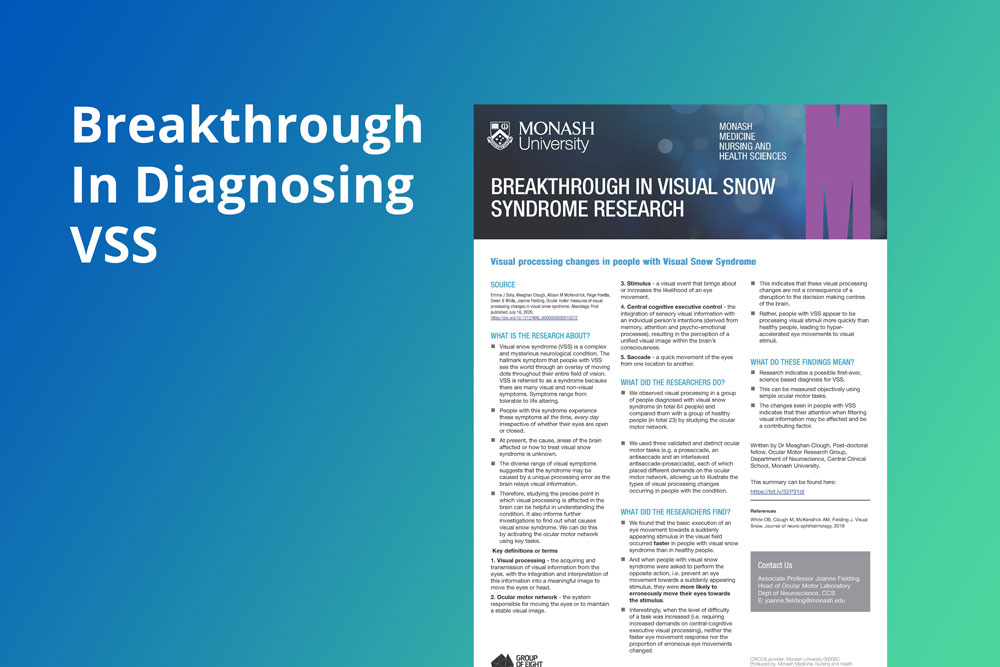What Is The Visual Snow Diagnosis Research About?
- Visual snow syndrome (VSS) is a syndrome because many visual and non-visual symptoms range from tolerable to life-altering.
- It is a misdiagnosed neurological condition since visual snow diagnosis is complex.
- Also, the cause, area of the brain affected, or how to treat visual snow syndrome is unknown
- In addition, the hallmark symptom is that people with VSS see the world through an overlay of moving dots throughout their entire field of vision.
- Besides, people with VSS experience these symptoms all the time, every day, irrespective of whether their eyes are open or closed.
- Indeed, a diverse range of visual symptoms suggests that a unique processing error may cause the syndrome as the brain relays visual information.
- Studying the precise point in which visual processing is affected in the brain can help us understand the condition and hence, visual snow diagnosis.
- Furthermore, investigations to find out what causes VSS can be done by activating the ocular motor network using key tasks.
Key Definitions & Terms
1. Visual processing – Acquiring and transmitting visual information from the eyes, integrating and interpreting this information into a meaningful image to move the eyes or head.
2. Ocular motor network – The system responsible for moving the eyes and maintaining a stable visual image.
3. Stimulus – A visual event that brings about or increases the likelihood of an eye movement.
4. Central cognitive executive control – Integration of visual sensory information with a person’s intentions (derived from memory, attention, and psycho-emotional processes), resulting in the perception of a unified visual image within the brain’s consciousness.
5. Saccade – Quick movement of the eyes from one location to another.
What DId The Researchers Do?
- A group of people (64) diagnosed with visual snow syndrome had their visual processing observed.
- Afterward, researchers compared them with a control group (23) by studying the ocular motor network.
- Three validated and distinct ocular motor tasks (e.g. a prosaccade, an antisaccade and an interleaved antisaccade-prosaccade) were perfomed.
- Each task placed different demands on the ocular motor network
- Therefore, allowing us to illustrate the types of visual processing changes occurring in people with the condition.
What Did The Researchers Find?
- Fundamental execution of an eye movement towards a suddenly appearing stimulus in the visual field occurred faster in people with VSS than in the control group.
- When people with visual snow syndrome performed the opposite action, i.e., prevent an eye movement towards a suddenly appearing stimulus, they were likelier to move their eyes towards the stimulus erroneously.
- However, when a task’s difficulty level increased (i.e., requiring increased demands on central-cognitive executive visual processing), neither the faster eye movement response nor the proportion of erroneous eye movements changed.
- Indicating that these visual processing changes are not a consequence of a disruption to the decision-making centers of the brain.
- Instead, people with VSS appear to be processing visual stimuli more quickly than healthy people, leading to hyper-accelerated eye movements to visual stimuli.
What Does This Mean For Visual Snow Diagnosis
- This research indicates a possible first-ever science-based visual snow diagnosis as revealed by, objectively using simple ocular motor tasks.
- Changes seen in people with VSS indicate that their attention when filtering visual information may be affected and may be a contributing factor.
Written by Dr. Meaghan Clough, Post-doctoral fellow, Ocular Motor Research Group, Department of Neuroscience, Central Clinical School, Monash University. Here is the research summary: Fielding/White group
References
White OB, Clough M, McKendrick AM, Fielding J. Visual Snow. Journal of neuro-ophthalmology. 2018
Emma J Solly, Meaghan Clough, Allison M McKendrick, Paige Foletta, Owen B White, Joanne Fielding. Ocular motor measures of visual processing changes in visual snow syndrome. Neurology. First published July 16, 2020, https://doi.org/10.1212/WNL.0000000000010372
Contact Us
Associate Professor Joanne Fielding
Head of Ocular Motor Laboratory
Dept of Neuroscience, CCS
E: [email protected]


